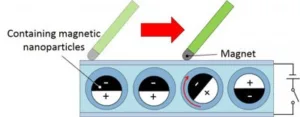A team of researchers led by Yusuke Komazaki in the Graduate School of Frontier Sciences at the University of Tokyo (Kashiwa, Chiba, Japan) is working to improve an e-paper technology that was invented in the 1970s. The goals of the team include creating an e-paper that can be written on by hand and that is both tougher and less expensive than its predecessors.
The most recent results of the team are reported in an article entitled “Electrically and magnetically dual-driven Janus particles for handwriting-enabled electronic paper”. It was published in the Journal of Applied Physics 117, 154506 (2015) and is available online here.
The display is composed of microparticles with a diameter of approximately 0.1 millimeter. As an example, one hemisphere of each particle is black and carries a negative charge. The other hemisphere is white and carries a positive charge. These so-called “Janus” particles are dispersed in a silicone elastomer that is synthesized by the use of a microfluidic method that is described in the article. The resulting sheet is layered between two parallel electrodes.
By switching the direction of the voltage across the electrodes, the color of the display can be switched between black and white. About 80 volts and between 0.3 and 0.5 seconds are required to switch the display between black and white states.
The idea of an electronically controlled “twisting ball” display is not new. What is new is that the researchers have included an additional capability, the ability to control the display by the use of a magnetic field. This is accomplished by adding super paramagnetic nanoparticles to the black side of the microparticles.
This innovation makes it possible for a user to write on the display screen by swiping a magnet across the surface of the display when the display is in its white state. Doing so attracts the black side of the balls thus flipping the balls such that those sides faces the magnet. As illustrated in the figure below, the procedure allows images to be drawn on the display. The process requires use of a magnet that has the strength about the same as that of a typical refrigerator magnet.

Images are maintained without the use of any power. Application of a voltage can, however, erase the images.
The team points out that the display is made from materials that are relatively inexpensive and hold up well under UV light. The researchers state that it is possible to change the two color combination presented by the display by substituting different microparticle pigments. Since the e-paper has a simple structure, the researchers feel that it enables the fabrication of physically large displays. With this the case, one of the applications envisioned by the team for the new e-paper technology is in whiteboards.
At this time, the team is investigating means to improve the contrast of the display. It believes this can be achieved by increasing the amount of pigment contained in the microparticles.– Arthur Berman
The University of Tokyo, Yusuke Komazaki, [email protected]

